Akasa Turing Fanless Case Review: Unrivalled Noiseless NUC
by Ganesh T S on October 26, 2020 8:00 AM ESTPower Consumption and Thermal Performance
The power consumption at the wall was measured with a 4K display being driven through the HDMI port. In the graphs below, we compare the idle and load power of the Intel NUC8i5BEK (Standard Kit) and the NUC8i5BEB (Akasa Turing) with other low power PCs evaluated before. For load power consumption, we ran the AIDA64 System Stability Test with various stress components, and noted the maximum sustained power consumption at the wall.
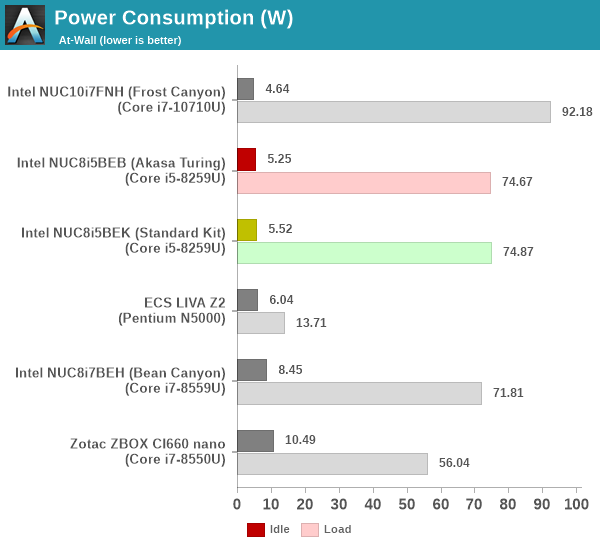
As expected, the peak and idle power consumption numbers for both configurations are in the same ballpark. The minor drop for the Turing configuration can be attributed to the absence of the cooling fan.
Our thermal stress routine starts with the system at idle, followed by four stages of different system loading profiles using the AIDA64 System Stability Test (each of 30 minutes duration). In the first stage, we stress the CPU, caches and RAM. In the second stage, we add the GPU to the above list. In the third stage, we stress the GPU standalone. In the final stage, we stress all the system components (including the disks). Beyond this, we leave the unit idle in order to determine how quickly the various temperatures in the system can come back to normal idling range. The various clocks, temperatures and power consumption numbers for the system during the above routine are presented in the graphs below. The interesting comparison here is between the behavior of the standard kit and the Turing configuration.
| Intel NUC8i5BEK (Standard Kit) System Loading with the AIDA64 System Stability Test | |||
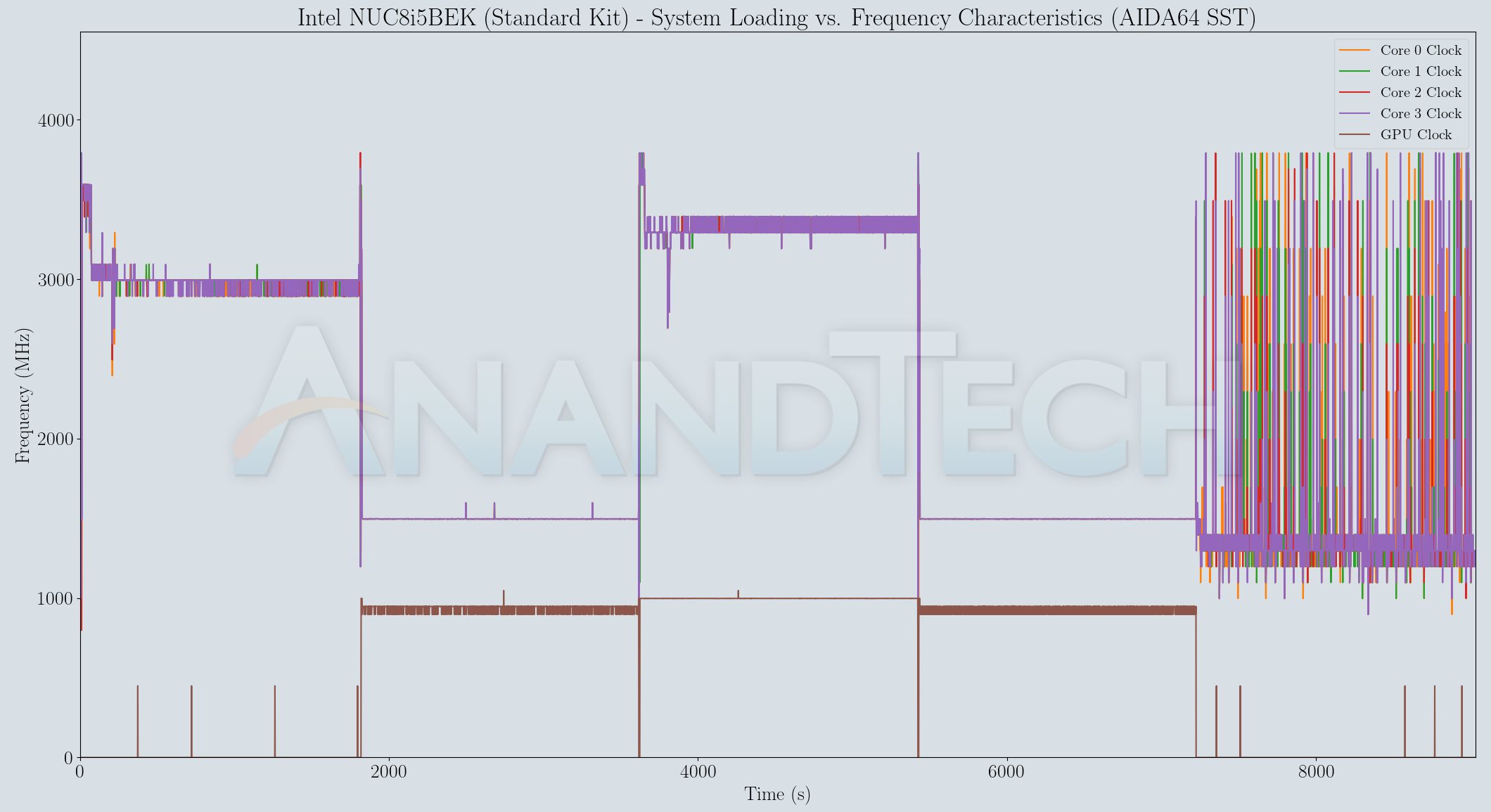
| Intel NUC8i5BEB (Akasa Turing) System Loading with the AIDA64 System Stability Test | |||
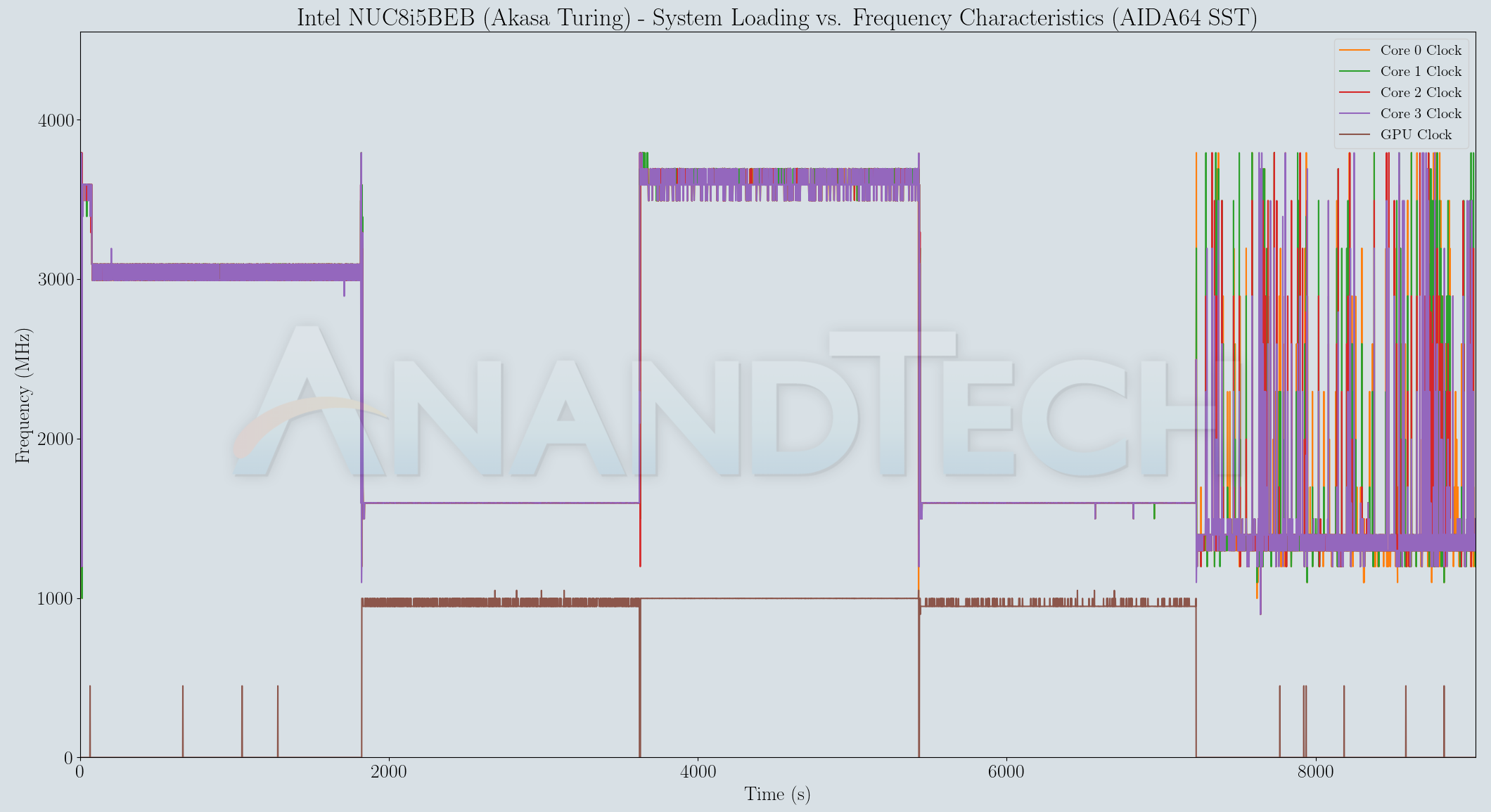
The Turing configuration is able to maintain slightly higher core clock frequencies during the actual workloads compared to the actively cooled kit. The temperatures present a clear reason - while the actively cooled version settles down around 90C during the first phase, it is around 80C for the Turing configuration. The drawback for the Turing build is with the disk stress - the presence of a thermal pad on top of the M.2 SSD in the standard kit enables the SSD temperature to stay well south of 60C. However, the Turing configuration lets the SSD go up to 80C (at which point the SSD probably starts throttling). The other aspect to note is the rate of drop in temperature after the load is removed - the actively cooled configuration goes below 40C quite quickly. In the same duration, the fanless version is still above 40C despite not reaching as high a temperature as the actively cooled configuration. The power numbers show that the package power with this particular BIOS configuration is capped at 30W outside the boost zone. We do see the actively cooled version stay in the boost zone longer than the fanless version - which probably explains why many of the benchmarks showed the standard kit with a slight edge.
| Intel NUC8i5BEK (Standard Kit) System Loading with Prime95 and Furmark | |||
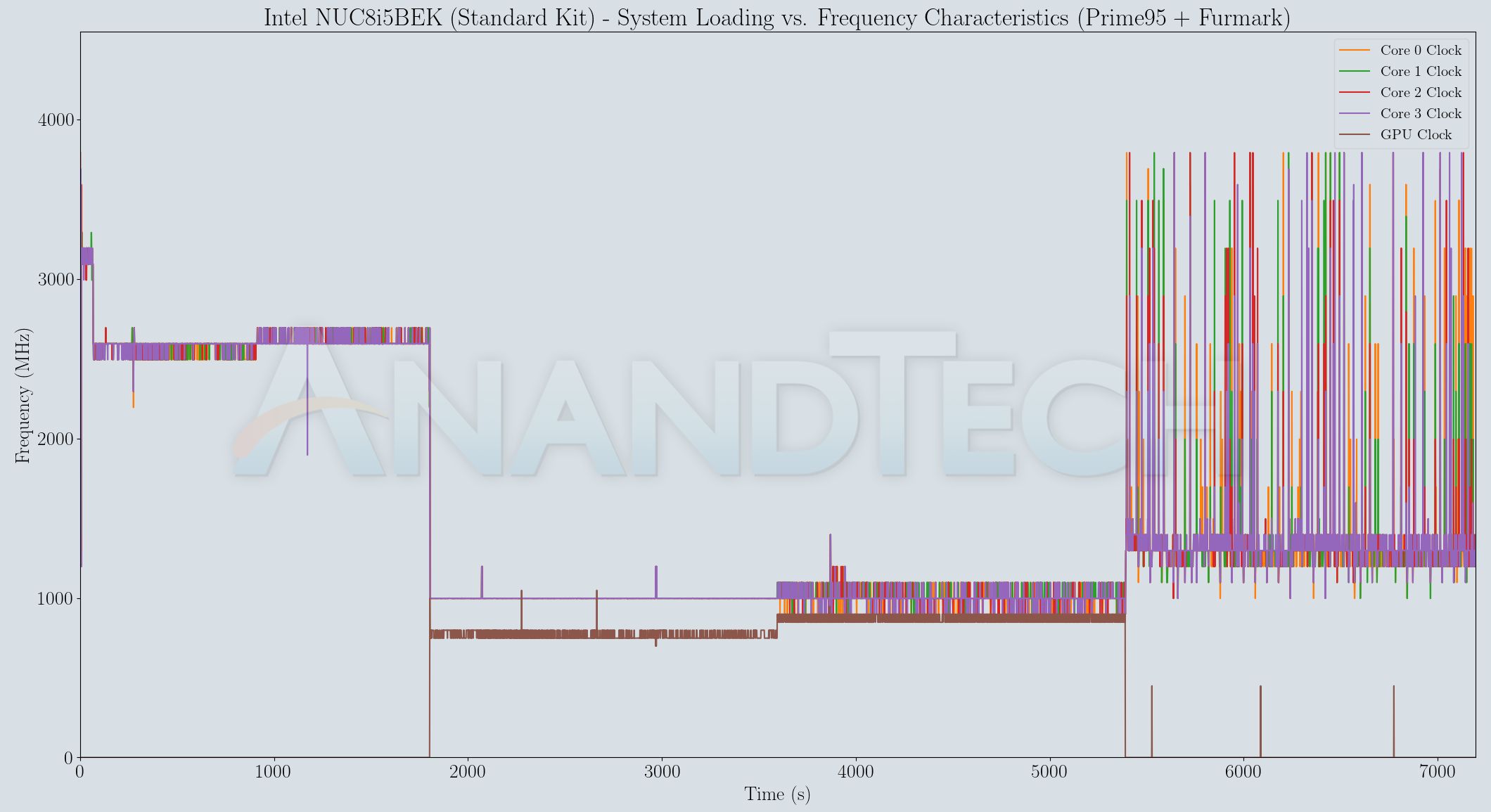
| Intel NUC8i5BEB (Akasa Turing) System Loading with Prime95 and Furmark | |||
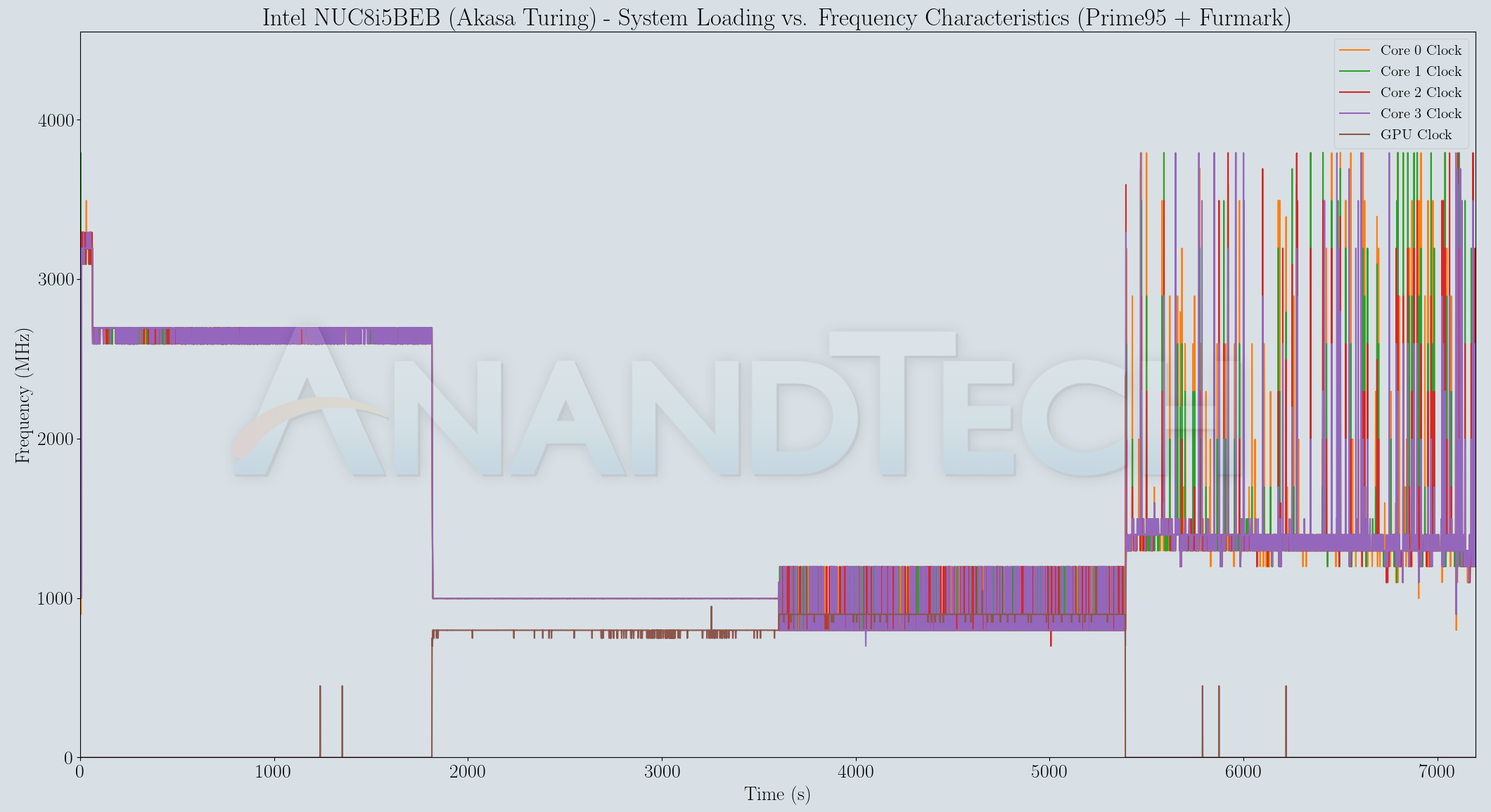
In the Prime95 case, the fanless version maintains steady frequency after the boost period, while the standard kit shows more variance around the same numbers. Once Furmark enters the picture, both the active and passive versions show similar frequency profiles for the components. The temperatures recorded during the process show the fanless version coming in at a full 10C below the actively cooled version. The larger heat sink / aluminum mass helps prevent thermal runaway of the sort happening in the standard kit (before the fan kicks in with full power to begin the cool-down). Power numbers again show slightly higher spikes in the boost zones for the standard kit.
The above results confirm the efficacy of the Akasa Turing to keep the system running at its maximum rated package power consumption numbers without thermal runaway. However, the exterior temperature may also be of concern in situations where the system is kept within touching distance. We recorded some thermal photographs of the unit using a FLIR ONE Pro camera towards the end of each of the stress test components.
The maximum observed temperature was 66.8C deep towards the base of the heat sink fins and out of touch.
The gallery above presents more thermal photos, showing that the segments of the chassis within touching distance reach around 57C under these artificially-stressful testing conditions.


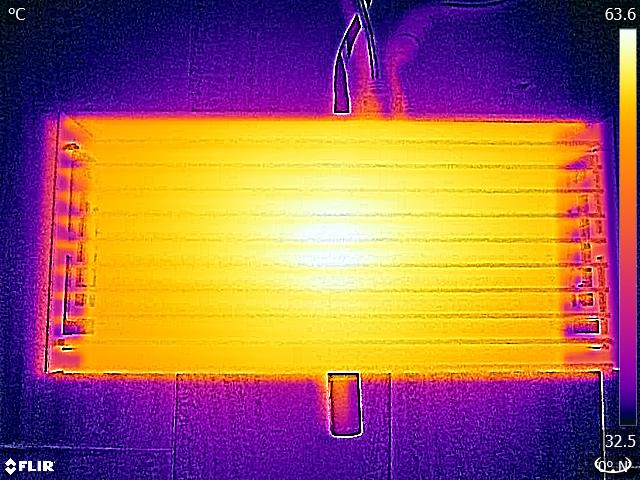
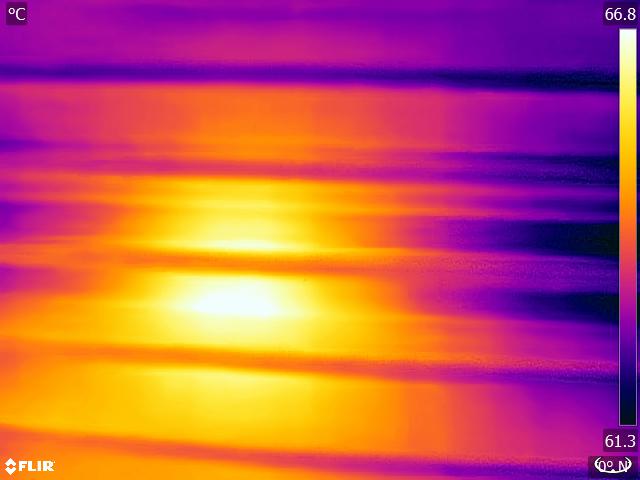














28 Comments
View All Comments
Hulk - Monday, October 26, 2020 - link
Great review. I'm very critical regarding computer noise and built a system using a Seasonic fanless power supply, Noctua cooler with 120mm fan and one 120mm case fan, both Noctua fans. I run the fans at about 1000rpm and the system noise is below my ability to hear unless I put my ear next to the case, and even then it's tough to hear anything. This is a "normal" 4770k non overclocked and it runs fine stock.My point is that I suggest anyone needing a silent system might be able to go with a passive power supply, large CPU air cooler, and quiet low rpm fans. You'll get virtually the same result for less money and a more powerful system.
emgarf - Monday, October 26, 2020 - link
Completely agree. It's not "portable", but I always build my systems in a full-size ATX tower and install 2x 140mm front intake, 1x 140mm bottom intake, and 1x 140mm rear exhaust Noctua fans. That way I can run them all at 700-800 rpm and maintain acceptable temps and essentially silent operation. I also usually oversize the (titanium-rated) power supply so that its fan never comes on in normal (< 50% capacity) operation.Hulk - Monday, October 26, 2020 - link
Yup. A number of large, high quality fans run at low rpm are virtually silent and move enough air to keep temps down.Oxford Guy - Monday, October 26, 2020 - link
‘Virtually silent’ is a vague concept. People with partial hearing loss may label quite noisy things in that manner. I also don’t know to what degree what someone notices is a 1:1 correspondence with what can irritate the person’s hearing.Droning fans, even when quieter than some noise sources, can be more irritating for a person with tinnitus. I presume this is due to a lack of rest intervals. High frequency emissions may also play a role. Some ball bearing fans are tuned to emit high frequencies.
Oxford Guy - Monday, October 26, 2020 - link
Many people also live in places with high levels of ambient noise pollution.Spunjji - Wednesday, October 28, 2020 - link
You're right about the vague concept. The fans they're describing will be running with FDB bearings, though, and not running at a speed that would produce any human-audible droning at common operating distances (1m+), assuming the sort of noise floor you'd expect in even a very quiet household environment.I'm not just stating that as an opinion - it's the sort of conclusion SPCR used to come to with their testing, and it's also my personal experience from building similar systems and testing them in quiet environments (quiet house, no HVAC, not near main roads).
AT_comma - Monday, October 26, 2020 - link
Look a lot like the new Xbox form factor. Perhaps made also to stay in place.Maksdampf - Monday, October 26, 2020 - link
I am pretty sure the Akasa Turing was designed to sit upright, not flat on the table. Upright position increases the thermal performance by a significant margin, even though it is already quite good thanks to the beefy heatsink.The way it was tested by Anandtech only uses the upper half of the heatsink for convection, the two lower parts are basically dummies with no possibility for natural airflow whatsoever.
Positioning the Case upright should not only improve overall thermal performance, but also speed up the cooldown time and improve the ssd temperatures a bit.
Apparently Akasa designed this to embedded standards, as there are no holes in the sides of the motherboard compartment which would improve airflow along the SSD due to natural convection, but would also be susceptible to Dust. A feature that is very liked in dusty Enviroments like industrial manufacturing, or weathery semi-outdoor applications etc.
Dust is one of the major drawbacks to "almost noiseless" fan designs like the one Hulk mentions in his Post below.
dontlistentome - Monday, October 26, 2020 - link
Maybe, but my 2 previous cases, the orientation made little difference in my room with no active air circulation. There's just not enough convection to cool the 30-40w heat coming from such a small area.The Von Matrices - Monday, October 26, 2020 - link
Look at the logos on the case. They're designed for the case to be horizontal, like it was reviewed.